
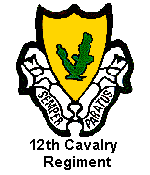
12th Cavalry Regiment
Organizational Legacy
"Always Ready"


| "Courtesy of Texas Highways, September 1990 Issue" |
|---|
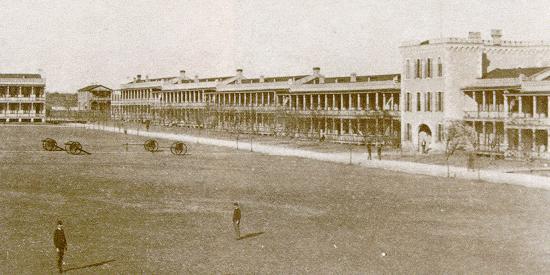 |
|---|
| Barracks and Officers' Quarters, Ft. Sam Houston - cira 1900 |
|---|

Regimental Distinctive Unit Insignia
 Introduction
Introduction


 The 1st Cavalry Division, a major subordinate command of the US Third Mobile
Armored Corps, is a 19,000 soldier, heavy armored division stationed at Ft.
Hood, TX. As one of the two "on-call" heavy contingency force divisions of the
Army, the First Team has an on-order mission to deploy by sea, air or land to
any part of the world on a short notice. The following narratives, divided in
timeline eras of major operational missions, describes the threat environment,
tactical conditions, evolution of equipment technology and the strategic
methodology employed by one of its subordinate units, the 12th Cavalry
Regiment, to contribute to the successful missions and enhancement of the
warring organization of the 1st Cavalry Division.
The 1st Cavalry Division, a major subordinate command of the US Third Mobile
Armored Corps, is a 19,000 soldier, heavy armored division stationed at Ft.
Hood, TX. As one of the two "on-call" heavy contingency force divisions of the
Army, the First Team has an on-order mission to deploy by sea, air or land to
any part of the world on a short notice. The following narratives, divided in
timeline eras of major operational missions, describes the threat environment,
tactical conditions, evolution of equipment technology and the strategic
methodology employed by one of its subordinate units, the 12th Cavalry
Regiment, to contribute to the successful missions and enhancement of the
warring organization of the 1st Cavalry Division.
3Mission:
 The mission of the 12th Cavalry Regiment is to, on order, deploy to a
contingency area of operations, prepare for, and conduct a full-spectrum
operation. It would then, on order, redeploy and prepare for future
operations.
The mission of the 12th Cavalry Regiment is to, on order, deploy to a
contingency area of operations, prepare for, and conduct a full-spectrum
operation. It would then, on order, redeploy and prepare for future
operations.
Organizational Summary:
 On 02 February 1901, the 12th Cavalry Regiment, currently represented in the
3rd and 4th Brigades of the 1st Cavalry Division, Ft. Hood, Texas was
constituted in the Regular Army. The regiment was organized 08 February 1901,
at Fort Sam Houston, Texas, with Colonel James N. Whelan, commanding. There
it was charged with protecting stage and mail routes, building and maintaining
forts, and establishing law and order in a vast area full of outlaws, Mexican
revolutionaries. During the years of 1901 and 1902, following the organization
at Ft. Sam Houston, companies of the regiment moved to Fort Clark, Fort Bliss
and Fort McIntosh, all located in Texas. The early history of 12th Cavalry
Regiment was closely tied to the movement of people and trading activities in
the areas of the south western plains and along the Mexican Border.
On 02 February 1901, the 12th Cavalry Regiment, currently represented in the
3rd and 4th Brigades of the 1st Cavalry Division, Ft. Hood, Texas was
constituted in the Regular Army. The regiment was organized 08 February 1901,
at Fort Sam Houston, Texas, with Colonel James N. Whelan, commanding. There
it was charged with protecting stage and mail routes, building and maintaining
forts, and establishing law and order in a vast area full of outlaws, Mexican
revolutionaries. During the years of 1901 and 1902, following the organization
at Ft. Sam Houston, companies of the regiment moved to Fort Clark, Fort Bliss
and Fort McIntosh, all located in Texas. The early history of 12th Cavalry
Regiment was closely tied to the movement of people and trading activities in
the areas of the south western plains and along the Mexican Border.
US Army Frontier Fort Locations In Texas
 As may be determined by the map below, the troopers of the 12th Cavalry
Regiment were garrisoned in facilities that were established as early as 1848,
1849 and 1852 to strategically protect the vast Texas frontier areas adjacent
to the Mexican border.
As may be determined by the map below, the troopers of the 12th Cavalry
Regiment were garrisoned in facilities that were established as early as 1848,
1849 and 1852 to strategically protect the vast Texas frontier areas adjacent
to the Mexican border.
 In 1903, the Regiment was deployed, by squadrons, to the Philippines,
completing the change of station on 30 August 1903. Following two tours
of duty in the Phillippines,the Regiment returned to the States in February
1911. THe 12th Cavalry had numerous assignments along with a wide range of of
graphical locations, such as Ft. Robinson, Nebraska; Ft. Huachuca and Ft.
Apache, both in Arizona; Ft. Meade, South Dakota; Gallup, New Mexico; El Paso,
Texas; and in 1913 - completing the chsin of assignments, back to Ft.
Robinson, Nebraska.
In 1903, the Regiment was deployed, by squadrons, to the Philippines,
completing the change of station on 30 August 1903. Following two tours
of duty in the Phillippines,the Regiment returned to the States in February
1911. THe 12th Cavalry had numerous assignments along with a wide range of of
graphical locations, such as Ft. Robinson, Nebraska; Ft. Huachuca and Ft.
Apache, both in Arizona; Ft. Meade, South Dakota; Gallup, New Mexico; El Paso,
Texas; and in 1913 - completing the chsin of assignments, back to Ft.
Robinson, Nebraska.
 The 12th Cavalry was one of several cavalry units that patrolled the Mexican
border before, during and after World War I. The border was patrolled
constantly, and because of the lack of roads in the area, the operations of
the cavalry was the only practical and effective way to monitor the activity.
In March 1920, major elements of the Regimenmt were deployed to Ft. McIntosh
located in Del Rio, Texas - adjacent to the Rio Grande and the Mexican border,
where they remained until 1921.
The 12th Cavalry was one of several cavalry units that patrolled the Mexican
border before, during and after World War I. The border was patrolled
constantly, and because of the lack of roads in the area, the operations of
the cavalry was the only practical and effective way to monitor the activity.
In March 1920, major elements of the Regimenmt were deployed to Ft. McIntosh
located in Del Rio, Texas - adjacent to the Rio Grande and the Mexican border,
where they remained until 1921.
 On 22 January 1921 the 1st Cavalry Division was constituted in the US Regular
Army. On 13 September 1921, with the initiation of the National Defense Act,
the 1st Cavalry Division was formally activated at Ft. Bliss, TX and Major
General Robert Lee Howze, a Texas native from Rusk County and seasoned veteran
of then Frontier Indian Wars, Spanish American War, Philippines Insurrection,
Mexican Expedition, World War I and recipient of the Medal of Honor, was
selected as its first Division Commander.
On 22 January 1921 the 1st Cavalry Division was constituted in the US Regular
Army. On 13 September 1921, with the initiation of the National Defense Act,
the 1st Cavalry Division was formally activated at Ft. Bliss, TX and Major
General Robert Lee Howze, a Texas native from Rusk County and seasoned veteran
of then Frontier Indian Wars, Spanish American War, Philippines Insurrection,
Mexican Expedition, World War I and recipient of the Medal of Honor, was
selected as its first Division Commander.
 Upon formal activation, the 7th, 8th and 10th Cavalry Regiments were assigned
to the new Division. With almost a century of service behind the oldest of its
regiments and sixty five years of service for its youngest, the units that had
already ridden and fought its way into the pages of history were organized
into the newly formed divisional structure. The four regiments were now to
fight side by side. Other units initially assigned to the 1st Cavalry Division
in 1921 included the 1st and 2nd Machine Gun Squadrons, Weapons Troops, 10th
Light Tank Company, 13th Signal Troop, 15th Veterinary Company, 27th Ordnance
Company, 43rd Ambulance Company, 82nd Field Artillery Battalion (Horse) and
the 1st Cavalry Quartermaster Trains which later was redesignated as the 15th
Replacement Company.
Upon formal activation, the 7th, 8th and 10th Cavalry Regiments were assigned
to the new Division. With almost a century of service behind the oldest of its
regiments and sixty five years of service for its youngest, the units that had
already ridden and fought its way into the pages of history were organized
into the newly formed divisional structure. The four regiments were now to
fight side by side. Other units initially assigned to the 1st Cavalry Division
in 1921 included the 1st and 2nd Machine Gun Squadrons, Weapons Troops, 10th
Light Tank Company, 13th Signal Troop, 15th Veterinary Company, 27th Ordnance
Company, 43rd Ambulance Company, 82nd Field Artillery Battalion (Horse) and
the 1st Cavalry Quartermaster Trains which later was redesignated as the 15th
Replacement Company.
 Later, on 18 December 1922, the 5th Cavalry Regiment was assigned to the 1st
Cavalry Division, relieving the 10th Cavalry Regiment. It would not be until
03 January 1933 that the 12th Cavalry Regiment, organized in 1901, would join
the 1st Cavalry Division, relieving the 1st Cavalry Regiment.
Later, on 18 December 1922, the 5th Cavalry Regiment was assigned to the 1st
Cavalry Division, relieving the 10th Cavalry Regiment. It would not be until
03 January 1933 that the 12th Cavalry Regiment, organized in 1901, would join
the 1st Cavalry Division, relieving the 1st Cavalry Regiment.
 The current capability of the 12th Cavalry Regiment has been developed in
conjunction with the long history of the 1st Cavalry Division. It is the
combination of the experienced training received by each dedicated member of
the Team and adherence to the performance level and traditions of the past.
Highlights of the many subsequent historical critical missions performed by
members of the 12th Cavalry Regiment and the honors they achieved are
summarized in the chapters that follow:
The current capability of the 12th Cavalry Regiment has been developed in
conjunction with the long history of the 1st Cavalry Division. It is the
combination of the experienced training received by each dedicated member of
the Team and adherence to the performance level and traditions of the past.
Highlights of the many subsequent historical critical missions performed by
members of the 12th Cavalry Regiment and the honors they achieved are
summarized in the chapters that follow:
 As of today, the 12th Cavalry Regiment is currently represented by the
following active units:
As of today, the 12th Cavalry Regiment is currently represented by the
following active units:
- The 1st Battalion, organized as a Combined Arms Battalion,
is assigned to the 3rd Brigade of the 1st Cavalry Division,
stationed at Ft. Hood, Texas.
- The 2nd Battalion, organized as a Combined Arms Battalion,
is assigned to the 4th Brigade of the 1st Cavalry Division,
stationed at Ft. Hood, Texas.

 This folio of material highlights of the many subsequent historical critical
missions performed by members of the 12th Cavalry Regiment, whose actions,
operations and the many critical issues resolved over its 108 year history to
meet the changing threat and the honors they achieved are summarized in the
following sections:
This folio of material highlights of the many subsequent historical critical
missions performed by members of the 12th Cavalry Regiment, whose actions,
operations and the many critical issues resolved over its 108 year history to
meet the changing threat and the honors they achieved are summarized in the
following sections:
 Table of Contents
Table of Contents


























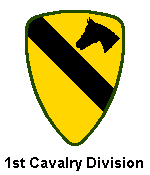



 If none of the data that you have found by surfing the reference unit chapter
titles and indexes measures up to your interests, you may want to deploy the
R&S (Reconnaissance and Surveillance) Scouts to search and identify keywords
or subjects within individual unit pages. Enter the descriptive keyword or
search terms(s) in the input field and "Click" on the Search button to screen the multiple DataBases of
the Cavalry OutPost and the garrisoned occupants - "The 1st Cavalry Division
and its Subordinate Units".
If none of the data that you have found by surfing the reference unit chapter
titles and indexes measures up to your interests, you may want to deploy the
R&S (Reconnaissance and Surveillance) Scouts to search and identify keywords
or subjects within individual unit pages. Enter the descriptive keyword or
search terms(s) in the input field and "Click" on the Search button to screen the multiple DataBases of
the Cavalry OutPost and the garrisoned occupants - "The 1st Cavalry Division
and its Subordinate Units".
 The search action will open the "first-team.us WebSite - R&S Scout Report",
which displays a listing of WebSite Titles and HTML Summaries that contain the
specific search term(s) of interest. To review any that best depicts a match
of your search term(s), "Click" on the WebSite Title to open a New Window.
After the WebSite is fully loaded, use the browser [EDIT/Find] Tool Button to
locate the search term within the page. After reviewing, close the New Window
to return to the listing of WebSites.
The search action will open the "first-team.us WebSite - R&S Scout Report",
which displays a listing of WebSite Titles and HTML Summaries that contain the
specific search term(s) of interest. To review any that best depicts a match
of your search term(s), "Click" on the WebSite Title to open a New Window.
After the WebSite is fully loaded, use the browser [EDIT/Find] Tool Button to
locate the search term within the page. After reviewing, close the New Window
to return to the listing of WebSites.
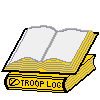



 If this is your first review of the Outpost of the 1st Cavalry Division and
its Subordinate Units, you may want to record your own report on your findings
during your visit, or perhaps you may want to review the log entries of other
visitors.
If this is your first review of the Outpost of the 1st Cavalry Division and
its Subordinate Units, you may want to record your own report on your findings
during your visit, or perhaps you may want to review the log entries of other
visitors.

To report on your findings,
"click" on the "Report-In"
Index Tab of the Troop Log. |
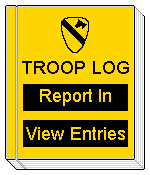
|

To review entries of others,
"Click"on the "View Entries"
Index Tab of the Troop Log. |
|---|

 As you journey through the history of the 1st Cavalry Division and its
assigned elements, you may find it interesting enough to send a message to
your friends and extend them an invitation for the opportunity to review the
rich history of the Division. We have made it easy for you to do. All that is
required is for you to click on the Push Button below, fill in their eMail
addresses and send.
As you journey through the history of the 1st Cavalry Division and its
assigned elements, you may find it interesting enough to send a message to
your friends and extend them an invitation for the opportunity to review the
rich history of the Division. We have made it easy for you to do. All that is
required is for you to click on the Push Button below, fill in their eMail
addresses and send.


|
The TITLE and URL of this WebSite are automatically read, formatted
and entered into your standard eMail form. |
|
|
Note - The eMail Message is processed and transmitted On-Line to the
addressee(s) via your Internet Provider.
Copyright © 2002, Cavalry Outpost Publications ® |




 eMail Your WebSite Comments.
eMail Your WebSite Comments.


 Return to "MyOwnPages"©.
Return to "MyOwnPages"©.

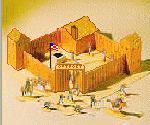 Copyright © 1996, Cavalry Outpost Publications ® and
Trooper Wm. H. Boudreau, "F" Troop, 8th Cavalry Regiment (1946 - 1947). All
rights to this body of work are reserved and are not in the public domain, or
as noted in the bibliography. Reproduction, or transfer by electronic means,
of the History of the 1st Cavalry Division, the subordinate units or any
internal element, is not permitted without prior authorization. Readers are
encouraged to link to any of the pages of this Web site, provided that proper
acknowledgment attributing to the source of the data is made. The information
or content of the material contained herein is subject to change without
notice.
Copyright © 1996, Cavalry Outpost Publications ® and
Trooper Wm. H. Boudreau, "F" Troop, 8th Cavalry Regiment (1946 - 1947). All
rights to this body of work are reserved and are not in the public domain, or
as noted in the bibliography. Reproduction, or transfer by electronic means,
of the History of the 1st Cavalry Division, the subordinate units or any
internal element, is not permitted without prior authorization. Readers are
encouraged to link to any of the pages of this Web site, provided that proper
acknowledgment attributing to the source of the data is made. The information
or content of the material contained herein is subject to change without
notice.
Revised 06 Apr '12 SpellChecked






 Introduction
Introduction


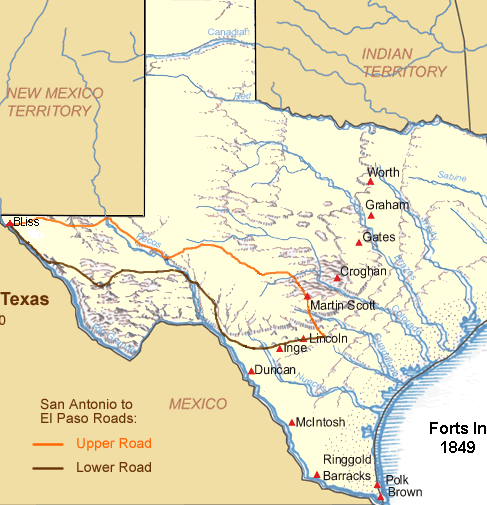















 Copyright © 1996, Cavalry Outpost Publications ® and
Trooper Wm. H. Boudreau, "F" Troop, 8th Cavalry Regiment (1946 - 1947). All
rights to this body of work are reserved and are not in the public domain, or
as noted in the bibliography. Reproduction, or transfer by electronic means,
of the History of the 1st Cavalry Division, the subordinate units or any
internal element, is not permitted without prior authorization. Readers are
encouraged to link to any of the pages of this Web site, provided that proper
acknowledgment attributing to the source of the data is made. The information
or content of the material contained herein is subject to change without
notice.
Copyright © 1996, Cavalry Outpost Publications ® and
Trooper Wm. H. Boudreau, "F" Troop, 8th Cavalry Regiment (1946 - 1947). All
rights to this body of work are reserved and are not in the public domain, or
as noted in the bibliography. Reproduction, or transfer by electronic means,
of the History of the 1st Cavalry Division, the subordinate units or any
internal element, is not permitted without prior authorization. Readers are
encouraged to link to any of the pages of this Web site, provided that proper
acknowledgment attributing to the source of the data is made. The information
or content of the material contained herein is subject to change without
notice.